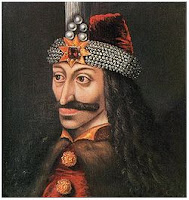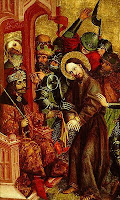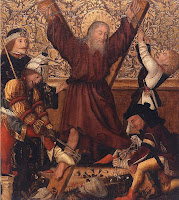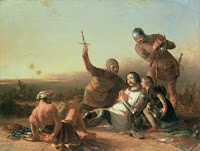Just how bad was Vlad?
Geoff Arnold’s recent post about Dracula’s castle for sale reminded me of a book I read some time ago called Sundays with Vlad: from Pennsylvania to Transylvania : one man’s quest to live in the world of the undead by Paul Bibeau. It’s a good read, if anyone’s interested in the obsession of vampires and why they’re so damned popular. His honeymoon actually involved a trip to Romania to find out more about Vlad the Impaler and the history behind him and the vampire mythology surrounding him.
David Lengyel wrote about a trip he took to the real fortress, not the castle for sale that helped inspire Stoker to write his classic. It’s 120 miles from Bucharest, high in the Carpathian mountains up hundreds of steps. Hardly a place for a party, or a good night’s sleep for that matter.
A uniformed figure stood a hundred steps above me, with an assault weapon and radio on hand. Perhaps he was guarding the castle, I thought, climbing toward him with my eyes cast down. Passing him, I pointed to the castle, saying “Dracula”. He smiled and said nothing. I realized he was guarding the rear flank of the hydro-electric plant hidden in the limestone canyon below.
Breaking through the trees, sweat dripping, I was atop the ridge in 30 minutes in full view of the castle and the road below. The bus was parked a few miles further up the canyon. I waved my arms. I could see everyone, but like Dracula’s reflection, no one could see me. I was in the 15th century now, thousands of miles from home, in an old fortress high on a mountain, home of “Vlad the Impaler”, killer of thousands.
Romanians consider him a national hero for his success in fighting off the Turks. He is most notorious for impaling invaders on wooden stakes and leaving their bodies to rot at public roadsides. History shows more than 10,000 Turks were impaled and displayed in nearby Targoviste. Many Romanians take offense at the West’s fascination with the count and the vampire icon he inspired.
The belief in vampirism is a modern day fear in many Romanian villages. In 1960 Boston College Professor Raymond McNally, co-author of “In Search of Dracula”, witnessed villagers in Rudne, near the Borgo Pass, plunging a wooden stake through the heart of an 18-year-old girl who had committed suicide. Other village practices to keep the dead supine include putting coins on the corpse’s eyelids, nailing heads to coffins, slitting the feet to prevent walking, and tying the hands to the feet.
Vlad was not a vampire, but he was fearsome. He’d been captured by Islamic Turks as a young man but he would not be converted from Christianity. They set him up as Prince of Wallachia, which they’d recently conquered, but he later fled to neighbouring Moldavia and enlisted the help of his own father’s killer to get a militia together and take care of the Turk problem. Later on in life, he considered himself to be a Crusader against the Turks but he wasn’t a fan of the Roman Catholics, either, resenting their expansion into Transylvania. From
Tabula Rasa: Writing, History and Horror
One of Dracula’s political rivals at the time was a priest, Vlad the Monk, who also happened to be his half-brother. Due to all sorts of complicated political pressures happening in Hungary (notably the conflict between László Hunyadi and Ladislas V), Dracula was becoming more and more dissatisfied with the German presence in Transylvania … and did something about it — diplomatically at first, requesting the German-occupied town of Sibiu to give up its support for Vlad the Monk. No reply was forthcoming, and Dracula struck, in an undeclared war, across the mountains, savagely destroying the populations of a number of villages and towns, and the property of the wealthy merchants and Boyars who were patrons to his half-brother. It was only the first of his raids on the country of his birth.
It’s for this behaviour that he gained notoriety. It’s doubtful Christians in the 1400s really concerned themselves with how many infidels were tortured and impaled or thrown off the high cliffs around the fortress. Vlad even hoped to become a saint because of his good works; he felt he was saving them from themselves. A priest apparently disagreed with his rationale and died horribly for doubting him.
He has a colourful history, that’s for sure. Romanians look at him as a hero, Germans a villian, and to Russians he’s considered “cruel but just”. It’s fascinating to read about him and the time he lived.
You know, Buffy met Dracula once but rather than embed another Buffy inspired vid, watch this one. You will sing along, the song will compel you…


 LinkBack URL
LinkBack URL About LinkBacks
About LinkBacks









 Citar
Citar

Marcadores